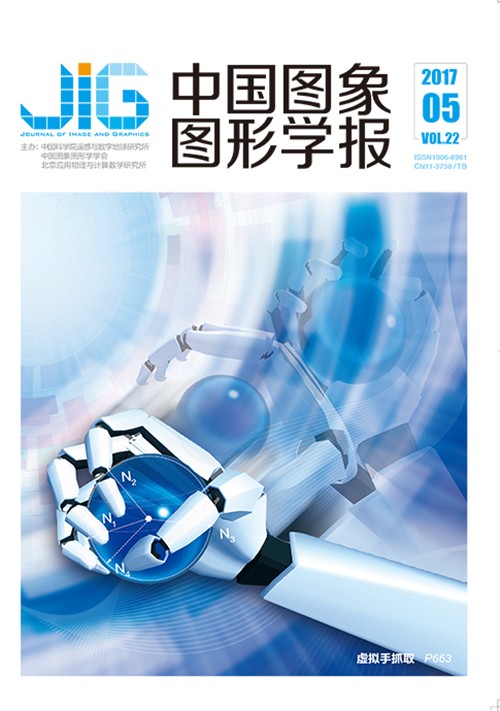
面向RGBD深度数据的快速点云配准方法
苏本跃1,2, 马金宇1,2, 彭玉升2,3, 盛敏2,3, 马祖长2,4(1.安庆师范大学计算机与信息学院, 安庆 246133;2.安徽省智能感知与计算重点实验室, 安庆 246133;3.安庆师范大学数学与计算科学学院, 安庆 246133;4.中国科学院合肥智能机械研究所, 合肥 230031) 摘 要
目的 真实物体的3维重建一直是计算机图形学、机器视觉等领域的研究热点。针对基于RGBD数据的非匀速非固定角度旋转物体的3维重建问题,提出一种利用旋转平台重建物体3维模型的配准方法。方法 首先通过Kinect采集位于旋转平台上目标物的深度数据和颜色数据,对齐融合并使用包围盒算法去除背景噪声和不需要的外部点云,获得带有颜色信息的点云数据。并使用基于标定物不同角度上的点云数据标定出旋转平台中心轴的位置,从而获得Kinect与旋转平台之间的相对关系;然后通过曲率特征对目标点云进行特征点提取并寻找与相邻点云的对应点;其中对于特征点的选取,首先针对点云中的任意一点利用kd-tree搜寻其k个邻近点,对这些点进行曲面拟合,进而计算其高斯曲率,将高斯曲率绝对值较大的n个点作为点云的特征点。n的取值由点云的点个数、点密度和复杂度决定,具体表现为能反映物体的大致轮廓或表面特征信息即可。对于对应点的选取,考虑到欧氏距离并不能较好反映点云中的点对在旋转过程中的对应关系,在实际配准中,往往会因为点云重叠或距离过远等原因找到大量错误的对应点。由于目标物在扫描过程中仅绕旋转轴进行旋转,因此采用圆弧最小距离寻找对应点可有效减少错误点对。随后,使用二分迭代寻找绕中心轴的最优旋转角度以满足点云间的匹配误差最小;最后,将任意角度获取的点云数据配准到统一的坐标系下并重建模型。结果 使用斯坦福大学点云数据库和自采集数据库分别对该方法和已有方法在算法效率和配准结果上进行对比实验,实验结果显示在拥有平均75 000个采样点的斯坦福大学点云数据库上与传统ICP算法和改进ICP算法相比,迭代次数分别平均减少86.5%、57.5%,算法运行时间分别平均减少87%、60.75%,欧氏距离误差平方和分别平均减少70%、22%;在具有平均57000个采样点的自采集点云数据库上与传统ICP算法和改进ICP算法相比,迭代次数分别平均减少94%、75%,算法运行时间分别平均减少92%、69%,欧氏距离误差平方和分别平均减少61.5%、30.6%;实验结果显示使用该方法进行点云配准效率较高且配准误差更小;和KinectFusion算法相比在纹理细节保留上也表现出较好的效果。结论 本文提出的基于旋转平台标定的点云配准算法,利用二分迭代算法能够有效降低算法复杂度。与典型ICP和改进的ICP算法的对比实验也表明了本文算法的有效性。另外,与其他方法在具有纹理的点云配准对比实验中也验证了本文配准方法的优越性。该方法仅采用单个Kinect即可实现对非匀速非固定角度旋转物体的3维建模,方便实用,适用于简单快速的3维重建应用场合。
关键词
Fast point cloud registration based on RGB-D data
Su Benyue1,2, Ma Jinyu1,2, Peng Yusheng2,3, Sheng Min2,3, Ma Zuchang2,4(1.School of Computer and Information, Anqing Normal University, Anqing 246133, China;2.The University Key Laboratory of Intelligent Perception and Computing of Anhui Province, Anqing 246133, China;3.School of Mathematics and Computational Science, Anqing Normal University, Anqing 246133, China;4.Institute of Intelligent Machines, Chinese Academy of Sciences, Hefei 230031, China) Abstract
Objective Three-dimensional reconstruction of real objects has always been a hot topic in computer graphics, computer vision, and other fields. In response to the 3D reconstruction of an object obtained with non-uniform rotating from non-fixed angle, a registration method to reconstruct an object 3D model based on RGB-D data is presented by using a rotating platform. Method Initially, the depth data and color data of the target on the rotating platform are collected by Kinect, and the bounding box algorithm is used to remove the background noise and external points to obtain the required point cloud data with color information. Subsequently, we use point cloud data calibration in different angles to calibrate the center axis of the rotating platform, thereby obtaining the relative relationship between Kinect and the rotating platform. Next, the curvature feature of the target point cloud is used to extract the feature points and find the corresponding points of adjacent point cloud, and then the feature points in non-overlapping regions. For the selection of feature points, we first use k-d tree to search for k neighboring points at any point in the point cloud, apply the surface fitting to these points, and then calculate the Gaussian curvature. The n points of the Gaussian curvature are larger as the characteristic points of the point cloud. The value of n is determined by the number of points, the density, and the complexity of the point cloud. Therefore, n points can reflect the approximate contours or surface features of the object. The Euclidean distance must be considered when selecting corresponding points to better reflect the rotation corresponding relationship of a pair of points in the point cloud in the process of rotation. In the actual registration, a large number of wrong correspondence points are frequently found using Euclidean distance because the point cloud overlap or points are too far away. The use of the arc minimum distance to find the corresponding point can effectively reduce the false point pairs because the target is rotated only around the axis of rotation during the scanning process. Third, the dichotomy iterations method is introduced to find the optimal rotation angle around a central axis, which meets the minimum of the registration error between the two points cloud. Finally, take the point cloud data acquired from any angle to obtain registration under the unified coordinate system and rebuild the model. Result The experimental results with Stanford University's point cloud database and self-collected database were compared with the existing methods. Compared with the traditional ICP algorithm and the improved ICP algorithm on the Stanford's point cloud database with an average of 75 000 sampling points, the iterative times are reduced by 86.5% and 57.5% respectively, and the running time of the two algorithms are reduced by 87% and 60.75% respectively. The mean square of the Euclidean distance error of the two algorithms is reduced by 70% and 22% respectively. Compared with the traditional ICP and the improved ICP algorithms on the self-collected database with an average of 57 000 sampling points, the average number of iterations is reduced by 94% and 75%, the running time of the algorithm is reduced by 92% and 69%, and the average mean squared of the Euclidean distance error is reduced by 61.5% and 30.6%. Experimental results show that the proposed method is more efficient and has less registration error. Compared with KinectFusion algorithm, this method also has good effects on texture detail preservation. Conclusion In this paper, the registration algorithm of point cloud based on rotating platform calibration is proposed, and the bisection iterative algorithm can effectively reduce the registration complexity. The comparison of the proposed algorithm and the traditional ICP and improved ICP algorithms also shows the effectiveness of the proposed algorithm. In addition, the superiority of this method is verified by comparing it with other methods in point cloud registration experiments with texture. In this method, only a single Kinect can be used to understand the 3-D modeling of non-uniform rotating objects with non-uniform rotation angles. This method is convenient, practical, and suitable for simple and rapid 3-D reconstruction applications.
Keywords
|



 中国图象图形学报 │ 京ICP备05080539号-4 │ 本系统由
中国图象图形学报 │ 京ICP备05080539号-4 │ 本系统由